The Incredibly Important work of Coyote Lewis Mehl-Madrona
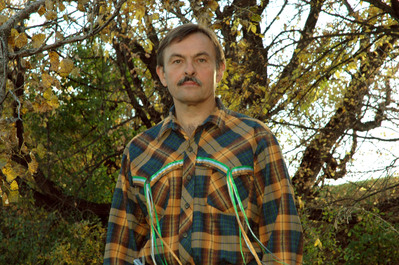
Recently I created a brief blog about the “Coyote” author, Lewis Mehl-Madrona,
and pictured four of his books. I got a rather large number of responses to that
blog, many thanking me for reminding them of a beloved teacher, and others
wanting more.
I had originally created that blog because of the overlap between his work on
“story” and the fundamental storytelling aspect of the Intuitive Heart Discovery
Program. Also, his having an indigenous background, Cherokee and Lakota, as well
as a Western education as an M.D. and Ph.D., made him like a perfect source of
information to support our efforts at creating an “indigenous gringo” form of
community healing and inspiration. In a sense, that ideal forms a part of his
self-declared mission statement. As a result of the response to my brief blog,
therefore, I contacted Dr. Mehl-Madrona. He and his wife Barbara Mainguy
recorded with me
a conversation where we explored some important topics in the overlap of our
concerns.
To accompany that recorded conversation, I am also presenting here a more
detailed description of his work, as revealed in his books. There are several
dimensions to his world that I wish to point out to the community that reads my
work:
·
Native American heritage, including Native healing methods, can be integrated
into Western M.D. medical practice in a way that improves outcomes and the
experience of healing for all concerned. Dr. Mehl-Madrona has demonstrated that
fact and has left a written record of exactly how it can be done in a way that
allows us “gringos” to get a handle on our own indigenous style. He points out
the universal human elements in his Cherokee-Lakota heritage tradition that make
up the “indigenous way” regardless of heritage.
·
We are not alone and we need each other. The indigenous approach to healing
emphasizes the importance of community and the redefining of self as “all my
relations.” In the story of my own personal and professional development [PUT
LINK], I move on from conducting “Dream Tent” for individuals to teaching folks
how they can conduct the Dream Helper Ceremony for their friends and neighbors.
I do so to move our focus away from the “professional healer” and “certified
patient,” to focusing on how one person’s challenge becomes an opportunity for
the person’s community to evolve.
·
Story, both as a process and product of human communication, and as an
alternative to the mechanical universe paradigm, is the center and medium of
healing. Here is an example of the Consciousness primary over Matter philosophy
in action. In a sense it is a story of dematerialization, as we shift our focus
onto what has been called the “virtual” world. It seems to be part of our
evolutionary trend. In my “Dream Tent” research, I demonstrated that it is not
the “pre-sleep stimulation” that “causes” the dream, but instead, the recalled
dream story evolves from the ritual story of the person’s reason for seeking a
dream in the first place—meaning trumps causality.
·
The structured inclusion of altered states of consciousness and psychic
phenomena into social and healing activities, and thus into the culture, if not
marginalized by criticism, denial, and teasing, can bring great benefits. In so
many of Dr. Mehl-Madrona’s stories, there occurs some use of an altered state of
consciousness. Some of the stories he tells his patients would definitely put
them in a reverie state. In other cases, he explicitly uses hypnosis. Sweat
lodge and vision quest rituals combine with dietary changes and exercise in
fashion that truly deserves the title “holistic.”
·
The confidence, based upon experience, to believe in and act upon one’s sense of
creative companionship and oneness with nature (including human samples),
including the ability to communicate with other life forms will facilitate our
transforming our lifestyle into something sustainable for planet earth.
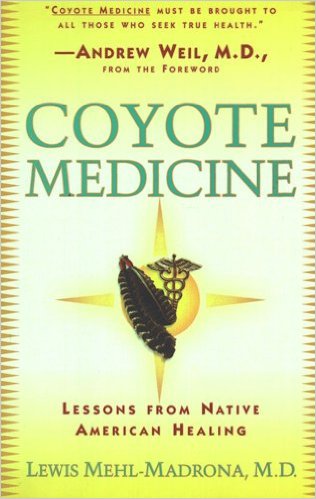
The first book by Lewis Mehl-Madrona is
Coyote Medicine: Lessons from Native American Healing.
Of all the books he’s produced, this one is essential reading. He tells in this
book the most personal stories about himself and his journey. It might well
someday rank among the important professional autobiographies, such as Carl
Jung’s Memories, Dreams and Reflections,
or Black Elk Speaks. It is a privilege
to witness a young man’s gradual recognition and appreciation of indigenous
methods, as it helps the reader also gain that perspective. Lewis stresses the
importance of story and he is, himself, a great story teller. I mean this
compliment both in regard to how he writes his book, and also with respect to
his actual story-telling treatments of his patients. It’s amazing how much
one-on-one time he spends with each patient. It’s quite a different model.
His personal story involves his conflicts, as a youth with his abusive
step-father. The pain and tension drives this young man to study. He propels
himself through college and medical school at an early age. Later he goes on for
a Ph.D. in clinical psychology. How he is drawn to healing, and how he finds his
way back to his indigenous heritage is an important part of his story. One of
the things that I think the gringos will appreciate is how he tells that story
of meeting with other Indians, learning about their ways. He is somewhat bashful
and a bit dubious, given his Western orientation, and so we as readers are
allowed to accompany him as he goes through his attitude adjustment. His writing
makes the “Indian” seem less “alien,” and thus, makes the indigenous perspective
more easily grasped and assimilated. It’s an important value of this book.
He begins in this book a process he further develops in his later books. He
shares with us his growing sense of a "method," a "formula" for healing through
story. In his first formulation, he says that we begin by listening to the
person's story, in the way the person tells it, and while doing so, listens for
something that can be used as a metaphor for the illness. Given that metaphor,
he can then begin to create a new story, a story of healing, that is based upon
turning the initial context of the metaphor into a new, more positive one. By
the final book (so far), as he demonstrates his evolved method, he provides many
hints to the reader as to how to facilitate each step.
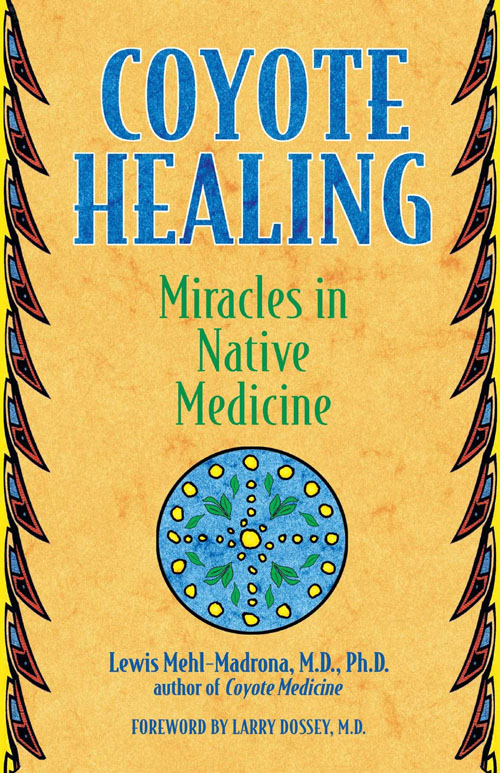
The second book by Dr. Mehl-Madrona is
Coyote Healing: Miracles in Native Medicine
This second book has a
substantive foreword by Larry Dossey on our reluctance to accept the idea of
miracles. In one sense, both Dossey and Mehl-Madrona are referring to healings
that shouldn’t have happened, because there was no known medical reason for a
healing, and the conditions were such that death was medically certain, yet the
patient got well, miraculously, through no apparent mechanism. Essentially, mind
over body healings are what he means by miracles. The more we learn about how
the mind affects the body, the sense of the miraculous seems to fade. A critic
says, “not all mysteries are miracles,” as if to suggest that the more we come
to understand about how things work, miracles become mechanisms.
Dr. Mehl-Madrona tells some stories here that shows that “story” can be
healing—not only can, but is the essential element in healing. He is not merely
using story as a metaphor for meaningful human interaction between patient and
doctor as the patient’s story is shared. One of his significant offerings from
Native medicine is the process by which the Dr. comes to realize the appropriate
metaphor, symbol, or story line that fits the patient’s situation. From there,
he creates a ceremony that will allow the patient to participate in the changing
of that story to a more healthy and happy version. The process can take awhile,
and Dr. Mehl-Madrona demonstrates a patience to which we are unaccustomed. He is
willing to take an inordinate amount of time with a patient. The stories he
tells the patient as part of the process takes several pages to recount in his
book. The process sounds like Milton Erikson hypnotherapy, which Dr.
Mehl-Madrona respects, but adding family and community to the mix. Here are the
essential elements necessary for a miracle, according to him:
-
Necessity of relationship. We don’t heal alone.
-
Importance of acceptance and surrender.
-
Focus on the present.
-
Importance of community
-
Transcending blame
-
Incorporating the spiritual dimension
-
Profound change in the person
In evolving from the first book to the second, Dr. Mehl-Madrona is slowly
developing a “formula.” I don’t mean to trivialize his process, but to point out
that he develops over time a systematization of the integrated multi-cultural
approach he takes. It is not willy nilly, but follows a meaningful sequence.
That is, he moves over time, from some intuitive generalities about special
qualities of the Native way, to beginning to describe a specific sequence of
events that are followed in a total healing package. Throughout the book, as we
read stories of folks who are not doing well in the traditional medical setting,
we see how differently from that model Dr. Mehl-Madrona works. He orchestrates a
healing sequence with the person.
What I found particularly striking and unusual was his chapter on “The Miracle
of Peacefulness.” Here he is taking up that attitude that is often discussed in
the context of explaining the difference between healing and curing. Getting
past self-blame for the illness, finding the blessings that can change from
unintended to gratefully acknowledged and cultivated, a sense of foregiveness
and openness to whatever the future may bring, such things of peacefulness are
the true miracles.
The indigenous secret is, “You are the healer.” To the journey around the
medicine wheel definitely involves getting to know one’s own inner healer. If
there is a method to cultivating miracles, then Dr. Mehl-Madrona attempts to
share with us how to put ourselves in the path of healing, a process and journey
that depends upon many factors beyond one’s own will, though the will to heal is
important.
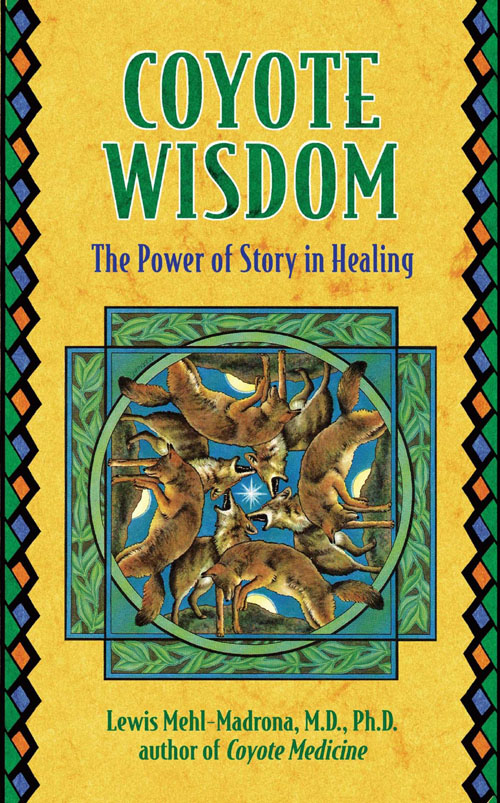
Coyote Wisdom: The Power of Story in Healing
is the third book in the series.
Among the Western healers Dr. Madrona has integrated into his work, none is more
important than Milton Erickson. This pioneer of quite idiosyncractic hypnosis
was a master story teller. At the end of the story, the patient had been on an
imaginary journey that often resulted in physical changes. The history of
hypnosis is full of examples suggesting that the power of mind trumps the
physical history of the body. Coyote Wisdom is a book dedicated to showing how
stories can be healing.
In this book,
Dr. Mehl-Madrona demonstrates how to introduce the story medicine into the
treatment. The first step is listening to the patient in such a way that the
patient is allowed to tell the story of the infirmity. This initial period is a
time for empathy and bonding between doctor and patient. The doctor learns the
patient’s language and the patient feels from the doctor what it is like to be
seen, understood, and cared about—healing in itself. The doctor begins to
explore where the patient might be most receptive to new elements of that story,
elements that support healing. Out of the information so gathered, the doctor
creates and shares with the patient a healing story, one specifically tailored
to inspire a new vision in the patient, an alternative future, a new approach to
a dilemma, or perhaps a change of heart.
The focus of this book is on the stories, the use of stories. The majority of
the chapters are devoted to discussing certain kinds of stories and their
effects upon the patient.
“Creation
stories tell us how things begin. Once we change our view of how things began,
we can start to imagine alternatives to the path we are following, perhaps even
found a route toward wellness.”
“Creation
stories inspire us to believe that we can get well. Fire stories encourage us to
make the effort. The quest for fire also opens the door for hero journeys toward
new worlds of growth and development. Stealing fire arises from our
dissatisfaction with the current state of affairs--the stimulus to growth and
change.”
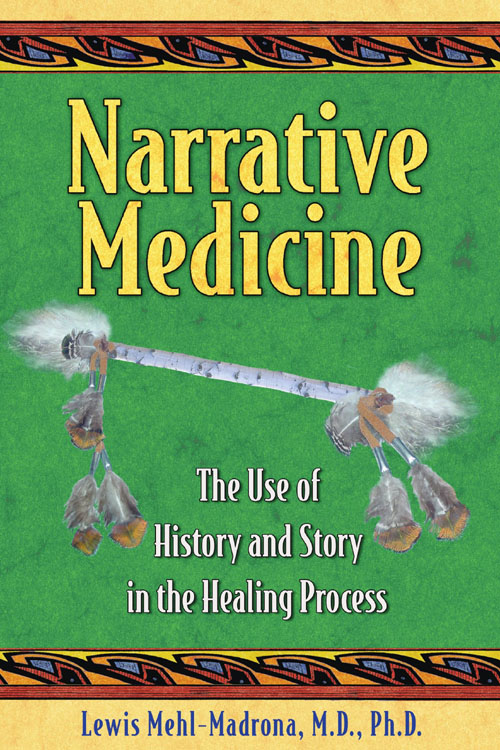
By the 1990s, a new trend in thought had been developing and making an
appearance. “Narrative psychotherapy” and “Narrative medicine” were newly
developing streams of thought, coming out of the “post-modern” mentality (which
grew out of physics’ indeterminancy principle—the observer affects the
observed). According to this perspective, there is no ultimate truth, only
stories about truth. Each person has their own story. Thus, there may not be an
objective approach to treatment, that is, one that works for all based upon
tried and true mechanical principles. Instead, we have great variability,
because the person’s story is going to have a great effect on how the mechanics
work.
In this book, Dr. Mehl-Madrona finally has a community of supporters, has a
“Western” approach that is open or sympathetic to the insights he has been
having on his own. He feels really validated and supported now in terms of his
approach, even if it is not widely accepted, because of the discovery of the
scholarly “narrative” philosophy. This book is full of notes and references, as
he can now link his experiences and ideas to many, many academic journal
articles describing this new perspective and related research.
There’s a big, important bonus to the narrative approach: An appreciation for
story provides a link between modern, scientific medicine and indigenous
medicine. This link becomes very important in his theorizing. It’s like he’s
found an intellectual “home” for his work.
Lewis Mehl-Madrona takes a step forward in this book and introduces the reader
to “Wolakota,” which is the name for the indigenous Lakota perspective on
things. He doesn’t say much about it, per se, so I looked it up on Google, and
discovered the Wo Lakota YouTube channel. This effort has to do with preserving
and teaching the Lakota way of life.
The shift in paradigm that LEWIS MEHL-MADRONAis sharing is one that moves from
the individual to the relationships. A good example of this kind of shift is his
finding the developmental psychologist Vygotsky, who argues that the child
learns through relationship, in contrast to the developmental psychologist
Piaget, who showed how the child learns through private experimentation. In
dealing with any illness, mental or physical, we look not merely at the
patient’s attributes, but more primarily at the patient’s relationships.
Of course, narrative healing occurs in a mental world very much different than
the mental world of traditional, or modern, healing. In the modern world, it’s
all a matter of biology, of the causal world of the mechanical/chemical
interactions of molecules. In the narrative world, there is no one cause, but
many contributing factors. Relationships, balance, and factors going beyond the
biology of the person, and into the person’s life engagement. Disease is not in
the organs, only the “fingerprint” of the disease. The disease lies in an
imbalanced relationship to the rest of life around the person, something that
story brings out. It’s a “systems” approach rather than a particle (organ,
chemical) approach.
“Transcending Limitations” is an important element in narrative healing. Stories
can inspire us about the possibility of overcoming limitations. The mechanical
forces in the physical body involved in the disease can be overcome by focused
consciousness. The story is more powerful than the physics. Altered states of
consciousness and symbolic, ritual ceremonies are important, therefore, in
getting us to a place where we can stand aside our usual story and be open to be
carried to a new story, so as to affect physical reality—i.e. healing. Community
participation in the ceremony builds the reality of the switch in story.
Is a shamanic ceremony the origins of scientific experiments? Conducting a
ceremony is not like moving the lever of a machine, but rather lobbying the
sentiments and intentions of a community of spirits to see what they might come
up with. The tool for research is the trained subtle awareness sensitivity of
the observers.
Repetitive prayer is a Native method in the healing ceremonies. It creates
absorption and single-pointed concentration. There is an element of persuasion
involved, especially to engage the cooperation of the spirits. He refers to the
“coherence” that a ceremony creates among the participants, which increases and
focuses the power of intent. Such comments as these are part of a systematic
presentation by Lewis Mehl-Madrona on the theory of ceremony in healing. It’s
good to see the logic of it spelled out. Once you recognize the power of story,
ceremony makes a lot of sense. A core aspect of healing ceremony is that
although it is highly structured via the story symbolism involved, there is a
crucial improvisational aspect…things can happen that evoke spontaneous
responses leading to healing.
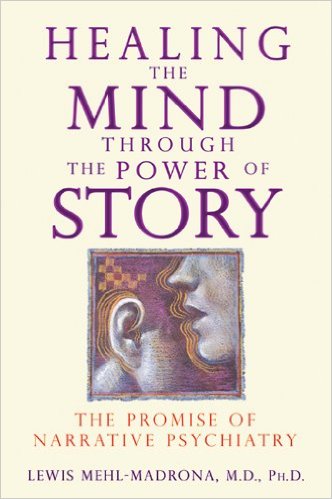
In this 5th
book, Lewis Mehl-Madrona has cleared the hurdles facing his task. He now feels
comfortable within a larger context of thought, having discovered the
“narrative” movement. He feels that his approach has been vindicated, approved,
and applauded, by the current trends of thinking.
In his
introduction to the book, he confides his confidence. Now that the power of
story has achieved recognition, even in the field of medicine, which deals with
the physical, and which concedes to “miracles” of the story, Lewis Mehl-Madrona
can relax and share how he uses the story method for psychological problems,
like depression, which might seem to be a less formidable challenge for stories
than curing cancer. Quite a studious fellow, Lewis Mehl-Madrona already was a
functioning MD when he went on to get a PhD in clinical psychology.
He also
pays tribute to two Native Americans from the past that are part of the heritage
of his own work. The first is His Crazy Horse, who had a vision that within
seven generations, the gringos would come to study Lakota spirituality and
medicine. Lewis Mehl-Madrona has helped that vision come true. The second is who
we know as Charles Eastman. He was an Oglala native, but became a Western
trained MD. Among several of his books is my favorite,
The Soul of an Indian. His books gave
Westerners a sense of what it is like to have the native mentality. His goal was
the same as Lewis Mehl-Madrona has today: to enrich our gringo culture with
Native American mentality.
As I’ve
mentioned before, I think this goal is important to us gringos, as I have found
a great degree of “indigenous” envy among us. We long for something more, yet
our culture keeps it at a distance, keeps a boundary between the material
reality and the life of spirit. One of the things I most gained from Eastman’s
book was to imagine what it is like not to have such a fixed boundary between
the living and the “dead.” Today the boundary is dissolving through more books
by psychic mediums who are bringing us more stories of the afterlife.
As we
have progressed through Lewis Mehl-Madrona’s books, we have received a
progressively more explicit statement as to what a native, or at least a Lakota
approach to healing might involve. In his book, he becomes a bit more explicit.
It certainly is not a formula approach, yet there is definitely a system. Of
course it begins with listening to someone’s story.
In this
book, he spends a chapter explaining the dynamics of ceremony. I was pleased to
feel a sense of validation in the way I had approached ceremony myself when
conducting some of my experiments. I see ceremony as enacted symbolism, he as
enacted story. We both see it as an improvisational activity rather than as a
rote activity. In working with altered states of consciousness, group intent,
and a symbolic structure that stimulates meaningful improvisation, you have the
ingredients on this side for effective ceremony. Now to include the humility to
call upon the spirits, first for permission to conduct such a ceremony, and then
for help in making the ceremony fertile, so that it gives birth to the desired
new stories (healing).
There can
be a systematic approach to engaging the irrational so that the mysteries of
life can be invited in to participate in the unfolding drama. It seems important
for folks to view ceremony in the constructive, creative manner that Lewis
Mehl-Madrona presents for us here. There’s an artistry involved.
In our
interview, I asked Lewis Mehl-Madrona about the essence of indigenous mentality,
and one important component was the humility to realize that healing requires
the community. Come together for healing. Create healing circles in your
community is his advice. People who have been together the longest in a group,
who have shared the most together, have the greatest chance of pulling off
healing miracles. It takes a community to effectively shift the story, and the
healing affects everyone.
He
writes, “People who pray together or share spiritual practice together week
after week become coherent with one another.” The Edgar Cayce Search for God
Study Group Program has offered folks this kind of unity for several decades
now. Members of such ongoing groups can testify to their importance and
effectiveness.
For the
first time in all his books, Lewis Mehl-Madrona takes the step of addressing the
reader, encouraging us all to find a way to form a healing circle. He encourages
us to reach out to our friends. The shared intent is more important than the
method used. Although he recognizes, of course, the value of persons
particularly gifted as healers, he nevertheless believes that the real power
comes from the group’s ability. The “expert” may be good at facilitating the
group’s ability. This chapter stands out from the rest and reminds me that when
I asked Lewis Mehl-Madrona what is the essential ingredient to seed the
indigenous mind within us, his answer was to form a healing circle. I think of
AA and the spirituality it has spawned.
The
symbol of the “talking stick” has become familiar in many communities, judging
from the number of occasions in which I’ve encountered its use. Often it is
presented as if it is assumed that folks already know about how it works, so
there’s been some assimilation in some quarters of gringoland.
Are there
really atoms, or are they illusions created by how waves behave? How do souls
exist, independent of their relationships among other souls? These quite
abstract questions are in the background as our consciousness evolves away from
a materialistic orientation. There’s a dematerialization going on in our
thinking and in the environment we are creating by our thinking. Echoing the
physicist who decades ago surmised that the universe seems like a giant thought,
Lewis Mehl-Madrona points out that we are made more out of stories than of meat
and potatoes:
It is
hard for me to convey the complex set of inter-related factors that Lewis
Mehl-Madrona describes in this book to make the point that stories are more
important than atoms. He brings to bear a number of leading thinkers from
various fields to describe reality in a very different way. If neuro-peptides
are the chemicals responsible for neuronal activity, allowing one nerve to
communicate with another, then stories are like social neuro-peptides. Yet these
non-material stories have the effect of shaping the growth of our brains. How we
as children are responded to by our parents has an effect on the brain and then
on how we process information.
The walls
around Lewis Mehl-Madrona’s work fall away in this book. There have been hints
of it all along, but here it is fairly explicit. It is a call for massaging our
culture, for allowing in new stories that would make it possible for us to
collaborate more effectively to promote a life affirming culture, instead of the
“dog-eat-dog” world we seem to have.
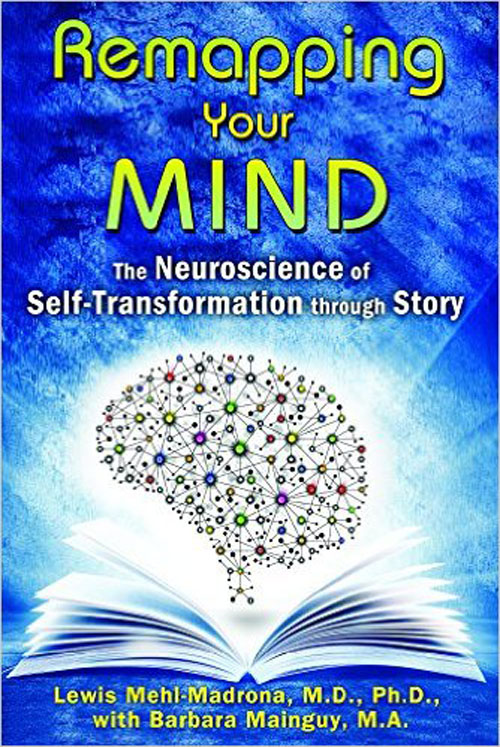
How is it
that something intangible, like hearing a story, can create or effect a change
that IS tangible, like a physical healing? For starters, imagine your brain on a
happy story versus imagine your brain on a sad story… different pattern of
physical brain activity in the two cases.
In
the previous book, many times Lewis Mehl-Madrona introduced research indicating
how the brain was quite plastic and responsive to the stories we hear and tell
ourselves. Earlier in his work, Lewis Mehl-Madrona was excited to realize that
the concept of “story” would allow him to build the bridge he wanted to build
between Western medicine and Indigenous medicine. Now he has added to the
various charms of story that story is the reality that allows us to understand
the connection between mind and matter, brain and experience.
As if
this were his final book, he is now presenting the evidence from brain research
and “neuroscience” that the brain is particularly suited to story, as if the God
had story and brain in mind as a dynamic duo to form a creative partnership to
evolve Creation. More specifically, this book is about how our brain evolved as
we evolved our story telling abilities. Our stories evolved our brain.
Continuing a trend that became quite evident in his previous book, Lewis
Mehl-Madrona is encouraging the reader to try some of his methods. In our
interview, he told me that with his wife’s help, they wrote some of these
chapters in a way that a reader might follow along and hopefully be able to get
involved with narrative healing, having a healing circle, performing some
ceremonies. The presenting of a systematic approach, a trend that has persisted
through these books, continues here, even more explicitly. Besides telling us
good stories, he has been laying out a framework as well.
I can’t
help but mention this little tease: Lewis Mehl-Madrona comes across excited that
brain research supports his story telling perspective. It’s odd to have story
finally grounded in the material world—the brain—given his story approach.
Actually, he said he wasn’t against pills and surgery, but jus that they need to
serve story, not operate as a self-willed, autonomous force for healing. Truth
be told, Lewis Mehl-Madrona is not anchoring story in brain, but showing how the
brain works with story, grows from story, as if the brain were designed to
function on story fuel, not fish, which has always been thought to be good brain
food.
They
(Lewis Mehl-Madrona and Barbara Mainguy are co-writing) lay out early in the
book the sequence of events in creating a healing. It begins, of course, with
listening to the person’s story. I’m reminded of Eckhart Tolle’s concept of the
“pain body” as Lewis Mehl-Madrona describes a person’s “nagi,” or collection of
stories a person has accumulated about who s(he) is. It seems like, to use a
metaphor, a heavy suitcase of baggage to be carrying around. Somewhere in those
stories is a clue to how the illness came about and the change that needs to
occur in order for there to be healing.
One of
the tasks in working with the stories is to find the shame or guilt that exists
surrounding the illness. It is a great barrier to healing. A shift in
perspective is helpful. I can give an example from dream interpretation work.
Retelling a dream from a different point of view, as if the dream belonged to
one of the other characters in the dream, or even one of the symbols, can bring
about amazing insights. It also frees the person from the box of the original
story.
Neuroscience provides Lewis Mehl-Madrona the information he needs to describe
“your brain on stories.” Brain function, differing states of consciousness, and
openness to change are all inter-related. One of the important functions of the
brain is to allow for hypothetical stories. We can imagine alternative futures,
conduct thought experiments. Working with story and brain function in a manner
compatible with healing allows for “virtual” therapies, imaginative experiences,
experiences in the realm of subtle energies, to have healing effect.
One
significant difference in this book, which Lewis attributes to Barbara, is the
frequent offering of “techniques” in little side bars. As they describe their
work, these techniques give hints to the reader concerning how the steps of
narrative therapy might be achieved. It is their attempt to encourage the reader
to try their methods. Clearly, at their institute they offer training to others,
as part of their mission to spread the story method. At this point, there is a
sense of mission accomplished. I suggested to Lewis that the next step might be
to go back and bring his first book up to date, sharing with us the various
personal experiences that carried him as far as it did to be able to present
this wonderful vision of what healing might be like and a culture that would
encourage it.
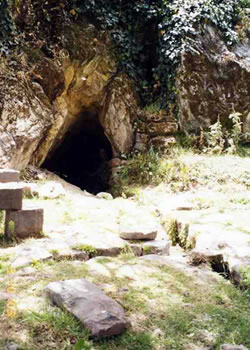
By way of conclusion:
Lewis Mehl-Madrona goes a long way toward providing an alternative
approach to healing. By showing that stories evolve the brain, he has joined the
"Integral" movement that sees evolution as being a product of the momentum of
consciousness, not the colliding of atoms and the survival of the fittest. He
doesn't come right out and say that mind is prior to matter, but I will offer,
as a final comment, a vision I had at an Incan water temple in Peru.
You can read the accompanying account of the role of water in
shamanism by going here:
http://www.intuitive-connections.net/2006/hrpp/hrpp.htm
I'm sitting in this cave, and I can see under the water the steps
going down, the walls lined with typical Incan stone. As I sit and meditate, I
can hear water dripping into the cave, from deep within. As I meditate on that
dripping, I begin to envision an "Ancient One," his face spread accross the
universe. He is chanting the story of the human being. His chant knows no bounds
and is instantly "heard" throughout the universe. The water on planet earth is
very receptive to the chant. It is absorbing the story of the human being as
this story is being chanted by the Ancient One. The water, educated with the
memory of the human story, pours out onto the earth and teaches the earth how to
create humans from dirt. Humans begin to emerge from the dirt.
I realized afterwards, on the drive back to Lima, that my vision
had integrated two, apparently different, versions of the Native American
creation story. In one version, the Natives came from a far away star. In
another version, they emerged from caves flowing out water. My vision included
both, and definitely was on the wavelength that story is the primary reality,
not materiality. Lewis Mehl-Madrona might not go that far, but I do believe we
are in an evolutionary process of "dematerialization" into a realm of virtual
reality.








